Last updated on January 22nd, 2024 at 13:36
A very common question on the majority of coffee lovers minds when starting their journey is “what are the different roasts of coffee?”
There are surprisingly fewer roast classifications and categories than you would think, and more coffee beans than you have heard about.
This article is the most detailed guide about the different roasts and beans that you will find anywhere on the internet.
There are only 6 different coffee roasts, unroasted, blonde, light, medium, medium dark and dark roast. Before I detail those roasts, let’s first detail the 4 types of coffee beans and why you need to roast them.
I’m full of beans and ready to get going!
The 4 Types Of Coffee Beans
Table Of Contents
As a coffee enthusiast and connoisseur, I encourage you to learn about the different coffee beans and roasts. This will not only improve your own knowledge, it will help you to understand how the flavors work and will turn you into an expert barista and coffee expert.
There are 4 main types of coffee beans:
- Robusta.
- Arabica.
- Liberica.
- Excelsa.
Each one of these beans has a very different flavor profile. Let’s talk about each of those in more detail before we move on to talking about the different roasts of coffee.

Coffee Curiosity: What does dark roast coffee taste like?
Robusta Beans
Starting with Robust since it is my current favorite after spending a few years in Vietnam. Robusta is the second most popular bean behind Arabica and by far the most common in Vietnam. The Robust bean is very robust, and resistant to diseases that affect the coffee plant.
Robusta thrives best in hot tropical climates where there is very irregular rainfall and can be cultivated at various altitudes. These beans have, on average, 1.7x the caffeine content than that of the more common Arabica beans and are often added to a bag of blended beans to boost their caffeine content.
The raw flavor of them is harsh, more harsh, yet with a smooth texture with a very slight chocolate hint. In my opinion, makes them fantastic for milk-based coffee drinks such as latte’s cortados and Iced Coffee.

Arabica Beans
You have absolutely already heard of Arabic coffee beans. Approximately 60% of all coffee sold in the world is from Arabica beans. Many coffee experts consider this type of bean to be higher quality. They contain less caffeine and, for espresso roasted beans need a little help from Robusta beans to give them a caffeine kick.
This type of bean grows at high altitudes in an area where there is regular, steady rainfall and has plenty of shade. This coffee plant is often allowed to grow into a tree. They are easy for coffee farmers to care for and prune as they don’t grow to a great height.
These beans are grown at high altitudes and need to be in an area that has a steady rainfall and plenty of shade. They are easily affected by their environment and are delicate and more prone to disease. Arabica beans are flavorsome and have a rich aroma.
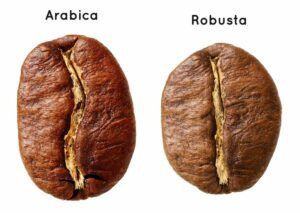
Excelsa Coffee Beans
Excelsa are classed as part of the Liberica family of coffee beans. This bean is grown predominantly in the South East of Asia and represents only 7% of the coffee sold in the world.
Typically, the Excelsa is grown at 1,100 to 1,300 meters altitude. Little is known about how it is brewed, roasted and traded due to its minimal presence in the world’s coffee market. It is known that it is cultivated in Africa and South East Asia. It is said to be of low quality with no particular flavor profile or characteristic.
Malaysia is the world’s largest producer of Excelsa coffee beans.
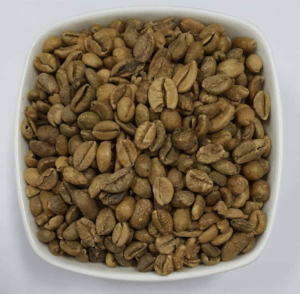
Liberica Coffee Beans
Liberica bean is one of the most difficult coffee beans to find. If you so happen to find them, then get your hands on them and try them as they are so difficult to find.
You will recognize them as they are the only coffee bean that has an irregular shape and is larger than the other beans. This coffee plant originates from the West African state of Liberia. It is said to taste like no other coffee with a complex flavor profile with a fruity, yet woody and smokey and slightly floral flavor.
They are known for their rich flavor and an amazing cup of coffee. This is why I suggest, if you see them, get them!
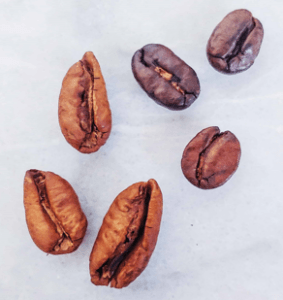
Green Coffee Beans
Okay if you are counting, this is the 5th coffee bean. In reality, it is not. All unroasted coffee beans, or better put, beans that have yet to be roasted, are green. The process of roasting reduces the chlorogenic acid content, which changes the color from the regular green.
So, when you hear the term “green coffee” know that they are referring to any unroasted coffee bean.
What Is Roasting Coffee Beans
The roasting of coffee beans is a heating process that transforms green coffee beans into a predetermined roast and flavor profile. The roasting process changes the beans color from green to a dark brown or almost black color depending on the roasting level, time and other factors.
Why Roast Your Coffee Beans
The green raw unroasted coffee beans (actually the seeds of the plant!) have a high water content which makes them difficult to grind. They also have a very, uggh, yukie taste to them that I can only describe as similar to grass. It is not surprising as they smell like grass.
When you roast them, this starts to dry out the water content and starts a wide range of chemical reactions in the beans that bring out the flavonoids, oils and aromas.
This first stage of roasting is known as the drying stage. Green beans, notably when first picked, can remain fresh for 12 to 18 months when stored at a constant 22C (72F).
The drying stage is performed at 165C until they yellow out in color. It is a very light yellow, almost a very pale watery, light brown color.
This is the very start of the roasting process.
The next stage is the light roasts which are roasted to the browning stage. At this point, the important reactions in the beans take place where the caramelization, Maillard reaction and Strecker degradation take place. This process brings out the aromas, oils and compounds that give the beans their acidity, sweetness and fruitiness.
This stage finishes at the first crack, the point at which the coffee beans start to crack open. It is most notable with the popping noises.
When all the water content inside the beans becomes darker, more brown and reaches a second crack. This second crack pulls out carbon, charcoal-like flavors with almost all the sugar compounds breaking down. Keep roasting beyond this point and the bean taste starts to become bittersweet and less acidic.
The light to medium roasts are roasted nearer the first crack. The dark roasts are roasted to the second crack typically. Very dark roasts like Italian, French and espresso roasts are often roasted beyond the second roast.
The 6 Different Coffee Roasts Explained
Now you know about the beans, what roasting is and why you should roast your beans and a basic overview of the roasting process, let’s get cracking and talking about and the different roasts of coffee beans.
Unroasted Beans
The unroasted beans are simply raw coffee beans that are freshly picked and known as the green beans that we spoke about earlier. All unroasted beans start their life out as green coffee beans and then get put through a VERY subtle and light roasting process that is the drying of the beans that then turn to a very slight yellow color.
Once they are dried, the coffee beans can then be roasted to any one of the following 6 main categories of roasts, which are detailed below.
At Latte Love Brew we highly recommend that you get your own green coffee beans and do your own home roasting for maximum freshness. Read up and learn about the green coffee bean and where you can buy them freshly picked or at most dried for you.

White Roast Coffee And Blonde Roast Coffee
A white roast is a very rare and hard-to-find roast that is also known as a half roast. The half roast name comes from the fact that they are roasted at the same temperature but for half the duration as a Blonde roast.
Due to the beans bieng very hard, they must be bought pre-ground as an industrial grinder is needed to grind them.
Don’t confuse white coffee, which is popular in Malaysia, Indonesia and Singapore as a white roast.
A blonde roast is the lightest of the light roast coffee and is the most commonly available of the light roasts, much more so than a white roast.
These coffee beans have a little more caffeine than other roasts, not much, just a little. The flavor profile of this roast is more floral with the flavors from the origin much, much, much more notable than medium and darker roasted coffee.
Light roasts take on more of the flavors from the beans while darker roasts get their flavor from the roasting process.

Light Roast Coffee Beans
A light roasted coffee bean is a new roast profile and one of the fastest growing and trending types of coffee roasts. Like a blonde roast, which fits into the category of this roast level. A light roast is light brown in color and has a matte surface.
Light roast beans maintain the unique characteristics of the beans from their location, soil, cultivation, altitude more than any other roast. The roasty taste that you experience is very similar and subtle, very much like a toasted grain.
Typical and common light roasts are cinnamon roast, which are roasted at 196C (385F) and New England Roast, which is roasted at 205C (401F). This is naturally speaking the lightest roast category.
The aforementioned white and blonde roasts form part of the light roast category.
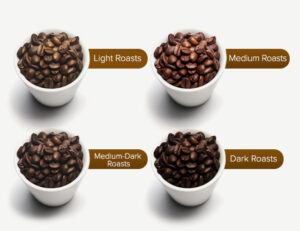
Medium Roast Coffee Beans
Medium roast coffees have a brown color which, is, due to roasting at a higher temperature, are slightly darker, by more than a few shades, than light roasted beans. This roasting level maintains the unique flavor profile and characteristics of the coffee beans and still has a nice balance of body and acidity.
Similar to light roasts, none of the coffee oils make their way to the beans surface layer. Unlike the light roast, they have no delicate flavors.
An American roast is a medium roast which is roasted at 210C (410F). A city roast is also classed as a medium roast and is roasted at 219C (426F).
A medium roast that can be left to roast for a little longer, become a little darker in color, are considered as a medium dark roast.
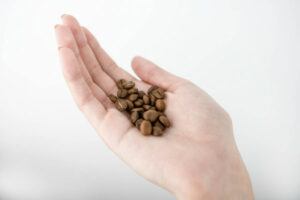
Medium-Dark Roast Coffee Beans
A medium-dark roast coffee bean has more of the bold body and rich flavors with a hint of a bittersweet aftertaste. The more subtle roasted almonds and dark chocolate flavors are associated with this roast profile.
Medium-dark roasts work great in a French press (as does any roast!) with a coarse grind. Commonly, you see people using other brewing methods, like the aeropress, moka pot, and drip brewers with this type of roast. For pour over coffee, a medium-coarse grind works best.
A medium dark roast coffee blend is often a mix of two beans, arabica and robusta with robusta there to enhance the caffeine content and has a touch of a bitter flavor.
Due to being roasted for slightly longer, it is darker than a medium roast, has a reduced acidity and deeper aroma. The oily surface is an indication of the coffee oils starting to come out.
Coffee roasting temperatures of 225C (437F) and 230C (446F) are used for Full City Roast and Vienna Roast, two common roasts that are categorised as a medium-dark roast. A medium dark roast is one of the most common and popular coffee bean roasts.

Dark Roast Beans
Dark roast coffee beans are a type of coffee bean that you are perhaps familiar with. They are roasted to a very dark brown, an almost mahogany color and almost black in some roasts. The oil on these roasted beans has the oil drawn out and glossing the surface.
Dark roasts unfortunately have their original flavors and profile and taste from their geographic location and country of origin roasted out. It is not advisable at all to roast your best beans or single origin beans to be roasted to a dark roast at all.
A dark roast will have a smoky, bold taste. A popular dark coffee roast is the French Roast which is roasted at 240C (464F), an Italian roast which is roasted at 245C (473F) and is the darkest roast of them all.
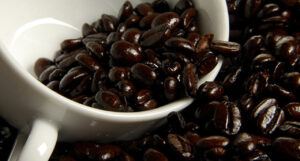
Espresso Roast
Like a blond roast, an espresso roast is not classified as one of the types of coffee roasts as such as it is a dark-roasted coffee bean. Due to its popularity, it is worthy of a mention and clarification. An espresso roast is roasted at the same temperature as a French roast (240C, 464F) but for a reduced amount of time.
An espresso coffee is ONLY made with an espresso roasted bean, otherwise it is not an espresso.
What Are The Different Roasts Of Coffee Frequently Asked Questions (FAQ)
Which Is Better Light Or Dark Roast Coffee?
This question is subjective and opinion based; what is better is based on an opinion and what type of coffee you want to drink and when. I have a few different favorite roast profiles depending on what I want and when.
Light roasts are better when you are using your specialty beans and want to draw out the location specific flavors and when you want that caffeine kick, as they are stronger in caffeine levels and have that distinct flavor. In my opinion, perfect for a morning coffee and best avoided, especially if robusta beans, late in the evening as you won’t sleep.
Dark roasts are better in the early evening due to a reduced level of caffeine and go great with chocolate and when you want a bolder richer taste to your coffee.
How Do You Choose A Coffee Roast?
Experience and trying and tasting different tasting types of coffee roasts is the best way of finding what roasts you like. Coffee is more about the beans than the roast. If you are buying specialty beans and want to experience the full range of flavors, then a lighter roast will be best.
If you are not so bothered or don’t want to taste the full range of the location-specific flavors, then look towards medium, medium dark roasts for these beans for more of the bold flavors to be brought out.
Selecting a roast type is a personal choice and what you are looking for at that specific moment for that coffee that you are about to brew and how you want those specific beans that you have just bought to taste and what flavors that you want to experience.
This is why I encourage your own home roasting: buy the beans and roast your own coffee and make a variety of roasts as you wish. Home roasting is becoming more popular and making a comeback. This is why.
Is Breakfast Blend Coffee A Light Roast?
Yes, a breakfast blend is a light roast. This blend is roasted to a light-medium roast profile. A breakfast roast, which they are commonly called, is not an actual roast type, it is a blend of different roasts and beans containing a mix of arabica and robusta beans, hence why it is called a blend.
What Do Different Roasts Of Coffee Mean?
As coffee beans move up and through the roasting process from light to dark the caffeine content reduces slightly, and the origin flavor gets roasted out and lost. Darker roasts have the least caffeine and are slightly less acidic. Dark roasts get their bold and smoky flavor from the oily surface. Medium roasts and light roasts have little oil on the surface of the beans. Light roasts, have almost none at all.
Which Coffee Roast Is Strongest?
In terms of a deep bold and traditional flavor a dark roast is the strongest. In terms of caffeine content, a light roast has more caffeine, slightly more.
The difference between a light roast and a darker roast in terms of caffeine content is approximately 10 mg of caffeine with all other variables being equal. It’s not an amount that you will notice at all.
Don’t make the mistake that a stronger taste equates to more caffeine.
Which Roast Is Smoothest?
Medium roasts are the smoothest and most balanced coffee. It is the most popular coffee roast in the world based on sales.
Frappé-Ing It All Up – What Are The Different Roasts Of Coffee?
When anyone asks you what are the different roasts of coffee? You can not only accurately tell them about the various roast but talk about and inform them about the different beans and how the roast affects the flavor profile and which beans are best and what has the most caffeine and why you should use which beans and which roasts.
Join our cool coffee club and take part by sharing your own coffee recommendations, creations, recipes and memes! Find us on Facebook/Meta.







